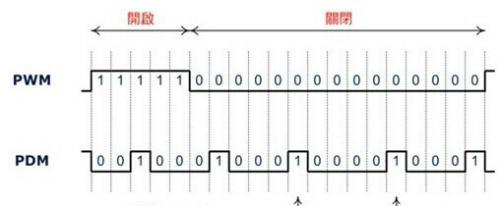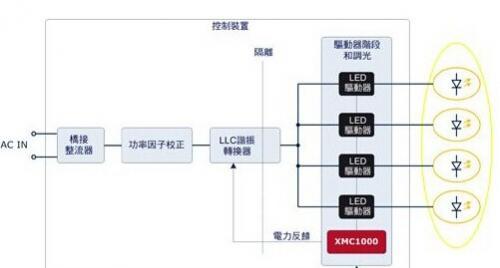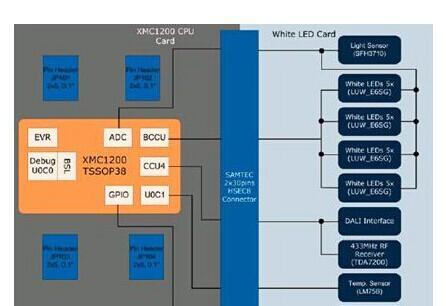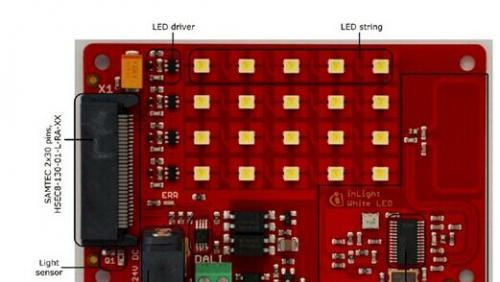基于英飞凌XMC1200 MCU的智能照明解决方案
 145
145
 拍明
拍明
原标题:基于英飞凌MCU的智能照明解决方案
基于英飞凌XMC1200 MCU的智能照明解决方案。MCU可助力实现LED照明智能化。LED照明系统商可依托内建BCCU功能的MCU,大幅缩短开发出智能高功率LED灯泡的上市时间,并协助终端使用者达成轻松且精准调光的目的,同时避免闪烁的问题。英飞凌XMC1200作为上述特性的单芯片解决方案,可以节省大量的CPU开销,大幅降低软件开发的时间,有效的减少人为导致的软件错误风险。同时XMC1200系列MCU具有高性能、大容量、高可靠性的特点,可以将智能照明广泛的应用于生活、工业的各个方面。
达成灯泡控制调变,LED开关切换速度成关键。调变指的是能够快速开关LED,若切换速度够快,人眼便无法辨识,看到的亮度将取决于LED开启的平均时间。最常见的调变方式为脉冲宽度调变(PWM)和脉冲密度调变(PDM)(图2)。其中,PDM能在对等的系统频率下达到更高的分辨率,电磁干扰(EMI)特性更佳,且因为本身切换速率高,因此不容易发生闪烁。

图1-大约25%亮度下的PWM和PDM调变
户外型LED灯泡的控制装置内包含电源供应器和驱动器。其中,标准电源供应器的重要器件包括桥接整流器、功率因子校正器(PFC)及半桥谐振(LLC)谐振转换器的降压转换器(图1)。

图2-四信道LED照明引擎范例
LED电流透过线性或切换式LED驱动器,固定为仔细选定的值,选定的LED电流则取决于系统器件和所需的最高亮度,如350毫安培(mA)或700毫安培。一般街灯的LED都以相同的电流驱动,建筑照明经常使用的多色灯泡,则可能使用完全不同的LED通道电流。调光时,通常是透过通讯,如数字可寻址照明接口(DALI)或传感器输入(如环境光源)触发;灯泡的亮度和/或颜色则是透过调变驱动器的输入(Enable Input)加以控制。
产业界所开发适用于LED照明的微控制器(MCU)包含亮度及色彩控制单元(BCCU),能在最多九个信道上产生PDM讯号。高功率调光灯泡的特殊挑战在于LED驱动器需要最短的停留时间,LED驱动器Enable Input的调变讯号必须在最短的时间间隔内保持恒定。从经验法则得知,功率越高需要的最短停留时间就越长,只有这样才能保持稳定且准确的LED电流。但在高分辨率和高比特率下,尤其是在低亮度的情况下,调变讯号却可能违反此要求。
目前产业界开发适用于LED照明的MCU可适时稍微重新排列调变讯号内的脉冲,自动解决此问题。脉冲会在分组电路内重新分组(图3),产生新的脉冲,拥有所需的最短宽度并兼顾分辨率,同时又能保持不闪烁。

图3-未分组PDM与已分组PDM范例比较
另一项需求则是将电源供应器的负载变动降到最低(使负载变流畅),尤其LLC谐振转换器对于高负载变动极为敏感。BCCU内的分组电路能够在不同的相对信道调变讯号间加入相移,确保讯号在不同的时间点变更状态。

图4-系统架构图
方案特色
隔离的DALI调光界面
温度检测
周围环境的亮度检测
433MHz射频控制方式

XMC1200
The XMC1200 devices are members of the XMC1000 family of microcontrollers basedon the ARM Cortex-M0 processor core. The XMC1200 series devices are optimized forLED Lighting and Human-Machine interface (HMI) applications.
XMC1200主要特性:
CPU Subsystem
? CPU Core
– High Performance 32-bit ARM Cortex-M0 CPU
– Most of 16-bit Thumb instruction set
– Subset of 32-bit Thumb2 instruction set
– High code density with 32-bit performance
– Single cycle 32-bit hardware multiplier
– System timer (SysTick) for Operating System support
– Ultra low power consumption
? Nested Vectored Interrupt Controller (NVIC)
? Event Request Unit (ERU) for programmable processing of external and internalservice requests
On-Chip Memories
? 8 kbytes on-chip ROM
? 16 kbytes on-chip high-speed SRAM
? up to 200 kbytes on-chip Flash program and data memory
Communication Peripherals
? Two Universal Serial Interface Channels (USIC), usable as UART, double-SPI,quad-SPI, IIC, IIS and LIN interfaces
? LED and Touch-Sense Controller (LEDTS) for Human-Machine interface
Analog Frontend Peripherals
? A/D Converters, up to 12 channels, includes 2 sample and hold stages and a fast 12-bit analog to digital converter with adjustable gain
? Up to 8 channels of out of range comparators (ORC)
? Up to 3 fast analog comparators (ACMP)
? Temperature Sensor (TSE)
Industrial Control Peripherals
? Capture/Compare Units 4 (CCU4) for use as general purpose timers
? Brightness and Colour Control Unit (BCCU), for LED color and dimming application
System Control
? Window Watchdog Timer (WDT) for safety sensitive applications
? Real Time Clock module with alarm support (RTC)
? System Control Unit (SCU) for system configuration and control
? Pseudo random number generator (PRNG), provides random data with fastgeneration times
Input/Output Lines
? Programmable port driver control module (PORTS)
? Individual bit addressability
? Tri-stated in input mode
? Push/pull or open drain output mode
? Configurable pad hysteresis
On-Chip Debug Support
? Support for debug features: 4 breakpoints, 2 watchpoints
? Various interfaces: ARM serial wire debug (SWD), single pin debug (SPD)
XMC1200 RGB LED照明板
The RGB LED Shield uses high frequency peak-current control with fixed off-times to generate DCLED currents. Although this is highly efficient, low cost, and is suitable for high-speed dimming, itresults in the output current being dependent on the input and output voltage ratio. The output currentcan be adjusted by configuring the peak-current reference and off-time parameters.
A virgin RGB LED Shield is pre-configured with safe peak-current reference and off-time parameters.
With the safe parameters, the LED current will not be ‘too high’ at high input voltages.The safe parameter values have been tested with LED loads that have a forward voltage of 6V atinput voltages up to 48V. At this input, the pre-configured average LED current is measured up to300mA.
The RGB LED Lighting Shield adds brilliant flicker-free light control to Arduino projects. The Shieldcommunicates with a master board via the I2C protocol as a slave. Either an Arduino Uno R3 or theXMC1100 Boot Kit from Infineon can be used as the master.
On board the RGB LED Shield is an XMC1202 microcontroller, featuring a dimming control peripheralfor LED lighting applications, known as the Brightness and Colour Control Unit (BCCU). It contains 3independent dimming engines and 9 independent Pulse Density Modulated (PDM) channels.
1 dimming engine and 6 channels are used in this shield.
There are 10 basic sets of I2C commands to control the shield from the master board, and so controlthe connected LED Lamp with various lighting effects. There are 22 user configurable parametersand the freedom to connect different LED Lamps.
The RGB LED Lighting Shield can be easily connected to any Arduino board or the XMC1100 boot Kitvia headers and DMX512 control is enabled as a mounting option using an interface chip.
XMC1200 RGB LED照明板主要特性:
? Behaves as an I2C slave.
?An Arduino Uno R3, XMC1100 Boot Kit, or similar board connected to the shield can
communicate via the SDA and SCL pins as the master.
? Drives and dims up to 3 LED strings with constant current.
? Able to change the colour of a connected LED lamp(if the strings are of different colours; forexample red, green, blue).
? High speed flicker-free modulation dimming on each string with Pulse-Density Modulation (PDM).
? Very high power density due to high switching frequency, leading to a small area.
? Up to 48VDC input.
?The RGB LED Shield is a DC-DC buck LED driver so the input voltage must be higher than theforward voltage of the LED strings.
? Configurable current amplitude.
? Up to 700mA average current on each string.
? Configurable current ripple.
? I2C interface with configurable 10-bit slave address (with a default value of 0x15E)
to increases the range of devices that can be connected to the bus line.
责任编辑:David
【免责声明】
1、本文内容、数据、图表等来源于网络引用或其他公开资料,版权归属原作者、原发表出处。若版权所有方对本文的引用持有异议,请联系拍明芯城(marketing@iczoom.com),本方将及时处理。
2、本文的引用仅供读者交流学习使用,不涉及商业目的。
3、本文内容仅代表作者观点,拍明芯城不对内容的准确性、可靠性或完整性提供明示或暗示的保证。读者阅读本文后做出的决定或行为,是基于自主意愿和独立判断做出的,请读者明确相关结果。
4、如需转载本方拥有版权的文章,请联系拍明芯城(marketing@iczoom.com)注明“转载原因”。未经允许私自转载拍明芯城将保留追究其法律责任的权利。
拍明芯城拥有对此声明的最终解释权。




 产品分类
产品分类















 2012- 2022 拍明芯城ICZOOM.com 版权所有 客服热线:400-693-8369 (9:00-18:00)
2012- 2022 拍明芯城ICZOOM.com 版权所有 客服热线:400-693-8369 (9:00-18:00)


